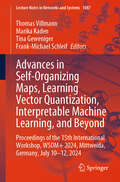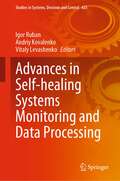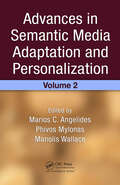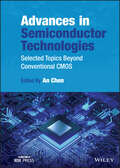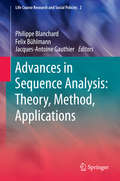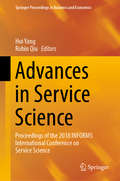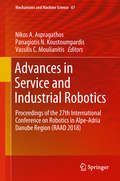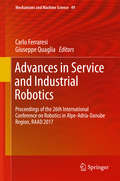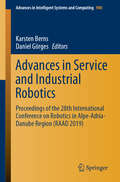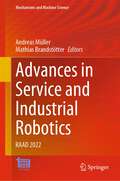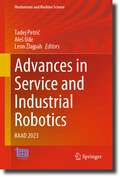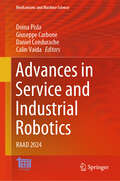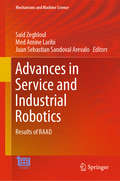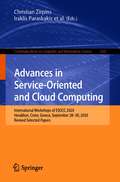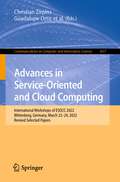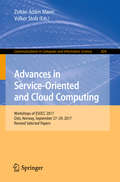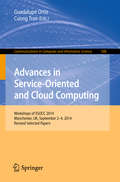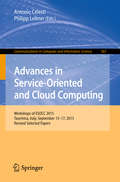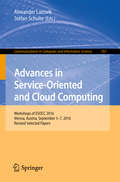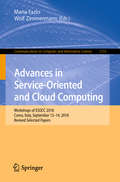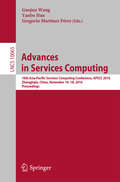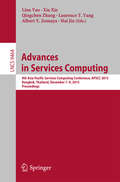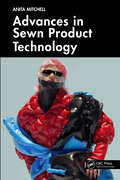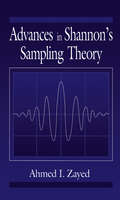- Table View
- List View
Advances in Self-Organizing Maps, Learning Vector Quantization, Interpretable Machine Learning, and Beyond: Proceedings of the 15th International Workshop, WSOM+ 2024, Mittweida, Germany, July 10–12, 2024 (Lecture Notes in Networks and Systems #1087)
by Thomas Villmann Frank-Michael Schleif Marika Kaden Tina GewenigerThe book presents the peer-reviewed contributions of the 15th International Workshop on Self-Organizing Maps, Learning Vector Quantization and Beyond (WSOM$+$ 2024), held at the University of Applied Sciences Mittweida (UAS Mitt\-weida), Germany, on July 10–12, 2024. The book highlights new developments in the field of interpretable and explainable machine learning for classification tasks, data compression and visualization. Thereby, the main focus is on prototype-based methods with inherent interpretability, computational sparseness and robustness making them as favorite methods for advanced machine learning tasks in a wide variety of applications ranging from biomedicine, space science, engineering to economics and social sciences, for example. The flexibility and simplicity of those approaches also allow the integration of modern aspects such as deep architectures, probabilistic methods and reasoning as well as relevance learning. The book reflects both new theoretical aspects in this research area and interesting application cases. Thus, this book is recommended for researchers and practitioners in data analytics and machine learning, especially those who are interested in the latest developments in interpretable and robust unsupervised learning, data visualization, classification and self-organization.
Advances in Self-healing Systems Monitoring and Data Processing (Studies in Systems, Decision and Control #425)
by Igor Ruban Vitaly Levashenko Andriy KovalenkoThis book presents the systematized research, development and improvement of methods in self-healing communication and control systems. The book presents new models and methods of data processing, focused on the specifics of self-healing systems. The goal is to equip the reader with the necessary knowledge about trends in monitoring and detecting failures, modelling processes and methods of data processing in self-healing communication and control systems.
Advances in Semantic Media Adaptation and Personalization, Volume 2
by Marios C. Angelides Manolis Wallace Phivos MylonasThe emergence of content- and context-aware search engines, which not only personalize searching and delivery but also the content, has caused the emergence of new infrastructures capable of end-to-end ubiquitous transmission of personalized multimedia content to any device on any network at any time. Personalizing and adapting content requires pro
Advances in Semiconductor Technologies: Selected Topics Beyond Conventional CMOS
by An ChenAdvances in Semiconductor Technologies Discover the broad sweep of semiconductor technologies in this uniquely curated resource Semiconductor technologies and innovations have been the backbone of numerous different fields: electronics, online commerce, the information and communication industry, and the defense industry. For over fifty years, silicon technology and CMOS scaling have been the central focus and primary driver of innovation in the semiconductor industry. Traditional CMOS scaling has approached some fundamental limits, and as a result, the pace of scientific research and discovery for novel semiconductor technologies is increasing with a focus on novel materials, devices, designs, architectures, and computer paradigms. In particular, new computing paradigms and systems—such as quantum computing, artificial intelligence, and Internet of Things—have the potential to unlock unprecedented power and application space. Advances in Semiconductor Technologies provides a comprehensive overview of selected semiconductor technologies and the most up-to-date research topics, looking in particular at mainstream developments in current industry research and development, from emerging materials and devices, to new computing paradigms and applications. This full-coverage volume gives the reader valuable insights into state-of-the-art advances currently being fabricated, a wide range of novel applications currently under investigation, and a glance into the future with emerging technologies in development. Advances in Semiconductor Technologies readers will also find: A comprehensive approach that ensures a thorough understanding of state-of-the-art technologies currently being fabricated Treatments on all aspects of semiconductor technologies, including materials, devices, manufacturing, modeling, design, architecture, and applications Articles written by an impressive team of international academics and industry insiders that provide unique insights into a wide range of topics Advances in Semiconductor Technologies is a useful, time-saving reference for electrical engineers working in industry and research, who are looking to stay abreast of rapidly advancing developments in semiconductor electronics, as well as academics in the field and government policy advisors.
Advances in Sequence Analysis: Theory, Method, Applications (Life Course Research and Social Policies #2)
by Philippe Blanchard Felix Bühlmann Jacques-Antoine GauthierThis book gives a general view of sequence analysis, the statistical study of successions of states or events. It includes innovative contributions on life course studies, transitions into and out of employment, contemporaneous and historical careers, and political trajectories. The approach presented in this book is now central to the life-course perspective and the study of social processes more generally. This volume promotes the dialogue between approaches to sequence analysis that developed separately, within traditions contrasted in space and disciplines. It includes the latest developments in sequential concepts, coding, atypical datasets and time patterns, optimal matching and alternative algorithms, survey optimization, and visualization. Field studies include original sequential material related to parenting in 19th-century Belgium, higher education and work in Finland and Italy, family formation before and after German reunification, French Jews persecuted in occupied France, long-term trends in electoral participation, and regime democratization. Overall the book reassesses the classical uses of sequences and it promotes new ways of collecting, formatting, representing and processing them. The introduction provides basic sequential concepts and tools, as well as a history of the method. Chapters are presented in a way that is both accessible to the beginner and informative to the expert.
Advances in Service Science: Proceedings of the 2018 INFORMS International Conference on Service Science (Springer Proceedings in Business and Economics)
by Hui Yang Robin QiuThis volume offers the state-of-the-art research and developments in service science and related research, education and practice areas. It showcases emerging technology and applications in fields including healthcare, information technology, transportation, sports, logistics, and public services. Regardless of size and service, a service organization is a service system. Because of the socio-technical nature of a service system, a systems approach must be adopted to design, develop, and deliver services, aimed at meeting end users' both utilitarian and socio-psychological needs. Effective understanding of service and service systems often requires combining multiple methods to consider how interactions of people, technology, organizations, and information create value under various conditions. The papers in this volume highlight ways to approach such technical challenges in service science and are based on submissions from the 2018 INFORMS International Conference on Service Science.
Advances in Service and Industrial Robotics: Proceedings Of The 27th International Conference On Robotics In Alpe-adria Danube Region (raad 2018) (Mechanisms and Machine Science #67)
by Nikos A. Aspragathos Panagiotis N. Koustoumpardis Vassilis C. MoulianitisThis volume contains the proceedings of the RAAD 2018 conference, covering major areas of research and development in robotics. It provides an overview on the advances in robotics, more specifically in novel design and applications of robotic systems; dexterous grasping, handling and intelligent manipulation; intelligent cooperating and service robots; advanced robot control; human-robot interfaces; robot vision systems and visual serving techniques; mobile robots; humanoid and walking robots; field and agricultural robotics; bio-inspired and swarm robotic systems; developments towards micro and nano-scale robots; aerial, underwater and spatial robots; robot integration in holonic manufacturing; personal robots for ambient assisted living; medical robots and bionic prostheses; intelligent information technologies for cognitive robots etc. The primary audience of the work are researchers as well as engineers in robotics and mechatronics.
Advances in Service and Industrial Robotics: Proceedings of the 26th International Conference on Robotics in Alpe-Adria-Danube Region, RAAD 2017 (Mechanisms and Machine Science #49)
by Carlo Ferraresi Giuseppe QuagliaThis volume contains the proceedings of the 26th International Conference on Robotics in Alpe-Adria-Danube Region, RAAD 2017, held at the Polytechnic University of Turin, Italy, from June 21-23, 2017. The conference brought together academic and industrial researchers in robotics from 26 countries, the majority of them affiliated to the Alpe-Adria-Danube Region, and their worldwide partners. RAAD 2017 covered all major areas of R&D and innovation in robotics, including the latest research trends. The book provides an overview on the advances in service and industrial robotics. The topics are presented in a sequence starting from the classical robotic subjects, such as kinematics, dynamics, structures, control, and ending with the newest topics, like human-robot interaction and biomedical applications. Researchers involved in the robotic field will find this an extraordinary and up-to-date perspective on the state of the art in this area.
Advances in Service and Industrial Robotics: Proceedings of the 28th International Conference on Robotics in Alpe-Adria-Danube Region (RAAD 2019) (Advances in Intelligent Systems and Computing #980)
by Karsten Berns Daniel GörgesThis book presents the proceedings of the 28th International Conference on Robotics in Alpe-Adria-Danube Region, RAAD 2019, held at the Fraunhofer Zentrum and the Technische Universität in Kaiserslautern, Germany, on 19–21 June 2019. The conference brought together academic researchers in robotics from 20 countries, mainly affiliated to the Alpe-Adria-Danube Region and covered all major areas of robotic research, development and innovation as well as new applications and current trends. Offering a comprehensive overview of the ongoing research in the field of robotics, the book is a source of information and inspiration for researchers wanting to improve their work and gather new ideas for future developments. It also provides researchers with an innovative and up-to-date perspective on the state of the art in this area.
Advances in Service and Industrial Robotics: RAAD 2021 (Mechanisms and Machine Science #102)
by Saïd Zeghloul Med Amine Laribi Juan SandovalThis book presents the proceedings of the 30th International Conference on Robotics in Alpe-Adria-Danube Region, RAAD 2021, held in Poitiers, France, 21–23 June 2021. It gathers contributions by researchers from several countries on all major areas of robotic research, development and innovation, as well as new applications and current trends. The topics covered include: novel designs and applications of robotic systems, intelligent cooperating and service robots, advanced robot control, human-robot interfaces, robot vision systems, mobile robots, humanoid and walking robots, bio-inspired and swarm robotic systems, aerial, underwater and spatial robots, robots for ambient assisted living, medical robots and bionic prostheses, cognitive robots, cloud robotics, ethical and social issues in robotics, etc. Given its scope, the book offers a source of information and inspiration for researchers seeking to improve their work and gather new ideas for future developments.
Advances in Service and Industrial Robotics: RAAD 2022 (Mechanisms and Machine Science #120)
by Andreas Müller Mathias BrandstötterThis book presents the proceedings of the 31st International Conference on Robotics in Alpe-Adria-Danube Region (RAAD), held in Klagenfurt, Austria, June 8-10, 2022. It gathers contributions by researchers from several countries on all major areas of robotic research, development and innovation, as well as new applications and current trends. The topics covered include: novel designs and applications of robotic systems, intelligent cooperating and service robots, advanced robot control, human-robot interfaces, robot vision systems, mobile robots, humanoid and walking robots, bio-inspired and swarm robotic systems, aerial, underwater and spatial robots, robots for ambient assisted living, medical robots and bionic prostheses, cognitive robots, cloud robotics, ethical and social issues in robotics, etc. Given its scope, the book offers a source of information and inspiration for researchers seeking to improve their work and gather new ideas for future developments.
Advances in Service and Industrial Robotics: RAAD 2023 (Mechanisms and Machine Science #135)
by Aleš Ude Tadej Petrič Leon ŽlajpahThis book presents the proceedings of the 32nd International Conference on Robotics in Alpe-Adria-Danube Region (RAAD), held in Bled, Slovenia, June 14-16, 2023. It gathers contributions by researchers from several countries on all major areas of robotic research, development and innovation, as well as new applications and current trends. The topics covered include: novel designs and applications of robotic systems, intelligent cooperating and service robots, advanced robot control, human-robot interfaces, robot vision systems, mobile robots, humanoid and walking robots, bio-inspired and swarm robotic systems, aerial, underwater and spatial robots, robots for ambient assisted living, medical robots and bionic prostheses, cognitive robots, cloud robotics, ethical and social issues in robotics, etc. Given its scope, the book offers a source of information and inspiration for researchers seeking to improve their work and gather new ideas for future developments.
Advances in Service and Industrial Robotics: RAAD 2024 (Mechanisms and Machine Science #157)
by Giuseppe Carbone Doina Pisla Calin Vaida Daniel ConduracheThis book presents the Proceedings of the 33rd International Conference on Robotics in Alpe-Adria-Danube Region (RAAD), held in Cluj-Napoca, Romania, June 5–7, 2024. It gathers contributions by researchers from multiple countries on all major areas of robotic research, development, and innovation, as well as new applications and current trends. The topics include perception and learning, medical robotics and biomechanics, industrial robots and education, kinematics and dynamics, motion planning and control, service robotics and applications, mobile robots and innovative robot design, etc. Given its scope, the book offers a source of information and inspiration for researchers seeking to improve their work and gather new ideas for future developments.
Advances in Service and Industrial Robotics: Results of RAAD (Mechanisms and Machine Science #84)
by Saïd Zeghloul Med Amine Laribi Juan Sebastian Sandoval ArevaloThis book gathers contributions by researchers from several countries on all major areas of robotic research, development and innovation, as well as new applications and current trends. The topics covered include: novel designs and applications of robotic systems, intelligent cooperating and service robots, advanced robot control, human-robot interfaces, robot vision systems, mobile robots, humanoid and walking robots, bio-inspired and swarm robotic systems, aerial, underwater and spatial robots, robots for ambient assisted living, medical robots and bionic prostheses, cognitive robots, cloud robotics, ethical and social issues in robotics, etc. Given its scope, the book offers a source of information and inspiration for researchers seeking to improve their work and gather new ideas for future developments. The contents reflect the outcomes of the activities of RAAD (International Conference on Robotics in Alpe-Adria-Danube Region) in 2020.
Advances in Service-Oriented and Cloud Computing: International Workshops of ESOCC 2020, Heraklion, Crete, Greece, September 28–30, 2020, Revised Selected Papers (Communications in Computer and Information Science #1360)
by Guadalupe Ortiz Winfried Lamersdorf Massimo Villari Claus Pahl Pierluigi Plebani Christian Zirpins Iraklis Paraskakis Vasilios Andrikopoulos Nane Kratzke Nabil El Ioini Andreas S. Andreou George Feuerlicht Willem-Jan Van den Heuvel Jacopo Soldani Giuliano CasaleThis volume contains the technical papers presented in the workshops, PhD Symposium and EU Projects Track which took place at the 8th European Conference on Service-Oriented and Cloud Computing, ESOCC 2020, held in Heraklion, Crete, Greece, in September 2020: 1st International Workshop on Edge Adoption and Migration, EdgeWays 2020, 16th International Workshop on Engineering Service-Oriented Applications and Cloud Services, WESOACS 2020, ESOCC 2020 PhD Symposium, ESOCC 2020 EU Projects Track. Due to the COVID-19 pandemic the conference and workshops were held in a virtual format. The 17 full papers and 2 short papers were reviewed and selected from 22 submissions. The papers focus on specific topics in service-oriented and cloud computing domains such as limits and/or advantages of existing cloud solutions, future internet technologies, efficient and adaptive deployment and management of service-based applications across multiple clouds, novel cloud service migration practices and solutions, digitization of enterprises in the cloud computing era, federated cloud networking services.
Advances in Service-Oriented and Cloud Computing: International Workshops of ESOCC 2022, Wittenberg, Germany, March 22–24, 2022, Revised Selected Papers (Communications in Computer and Information Science #1617)
by Guadalupe Ortiz Massimo Villari Christian Zirpins Jacopo Soldani Zoltan Nochta Oliver Waldhorst Damian TamburriThis volume contains the technical papers presented in the workshops, which took place at the 9th European Conference on Service-Oriented and Cloud Computing, ESOCC 2022, held in Wittenberg, Germany, in March 2022.The 4 full papers and 7 short papers included in these proceedings were carefully reviewed and selected from 17 submissions. The workshop proceedings volume of ESOCC 2022 contains contributions from the following workshops and events:First International Workshop on AI for Web Application Infrastructure and Cloud Platform Security (AWACS 2022)PhD Symposium of ESOCC 2022ESOCC 2022 Projects TrackESOCC 2022 Industrial Track
Advances in Service-Oriented and Cloud Computing: Workshops Of Esocc 2017, Oslo, Norway, September 27-29, 2017, Revised Selected Papers (Communications In Computer And Information Science #824)
by Zoltán Ádám Mann Volker StolzThis volume contains the technical papers presented in the workshops, which took place at the 6th European Conference on Service-Oriented and Cloud Computing, ESOCC 2017, held in Oslo, Norway, September 2017: First International Workshop on Business Process Management in the Cloud, BPM@Cloud 2017; Third International Workshop on Cloud Adoption and Migration, CloudWays 2017.
Advances in Service-Oriented and Cloud Computing: Workshops of ESOCC 2014, Manchester, UK, September 2-4, 2014, Revised Selected Papers (Communications in Computer and Information Science #508)
by Guadalupe Ortiz Cuong TranThis volume contains the technical papers presented in the four high-quality workshops associated with the European Conference on Service-Oriented and Cloud Computing, ESOCC 2014, held in Manchester, UK, in September 2014: 4th International Workshop on Adaptive Services for the Future Internet, WAS4FI 2014, 2nd International Workshop on Cloud for IoT, CLIoT 2014, 2nd International Workshop on Cloud Service Brokerage, CSB 2014, and Seamless Adaptive Multi-cloud Management of Service-based Applications, SeaCloudS Workshop. The 19 revised full papers and 3 short papers were carefully reviewed and selected from 39 submissions. They focus on specific topics in service-oriented and cloud computing domains as cloud computing, service buses, Web services, service-oriented architectures, event-driven architectures, enterprise architectures, business process management, software selection and adaptation.
Advances in Service-Oriented and Cloud Computing: Workshops of ESOCC 2015, Taormina, Italy, September 15-17, 2015, Revised Selected Papers (Communications in Computer and Information Science #567)
by Antonio Celesti Philipp LeitnerThis volume contains the technical papers presented in the seven high-quality workshops associated with the European Conference on Service-Oriented and Cloud Computing, ESOCC 2015, held in Taormina, Italy, in September 2015: Third International Workshop on Cloud for IoT (CLloT 2015), 5th International Workshop on Adaptive Services for the Future Internet (WAS4FI 2015), Second Workshop on Seamless Adaptive Multi-cloud Management of Service-Based Applications (SeaClouds 2015), First International Workshop on Cloud Adoption and Migration (CloudWay 2015), First International Workshop on Digital Enterprise Architecture and Engineering (IDEA 2015), First Workshop on Federated Cloud Networking (FedCloudNet 2015). Abstracts of the presentations held at the European Projects Forum (EU Projects 2015) are included in the back matter of this volume. The 25 full papers and 6 short papers were carefully reviewed and selected from 48 submissions. They focus on specific topics in service-oriented and cloud computing domains such as limits and /or advantages of existing cloud solutions, Future Internet technologies, efficient and adaptive deployment and management of service-based applications across multiple clouds, novel cloud service migration practices and solutions, digitization of enterprises in the cloud computing era, federated cloud networking services.
Advances in Service-Oriented and Cloud Computing: Workshops of ESOCC 2016, Vienna, Austria, September 5–7, 2016, Revised Selected Papers (Communications in Computer and Information Science #707)
by Stefan Schulte Alexander LazovikThis volume contains the technical papers presented in the workshops associated with the European Conference on Service-Oriented and Cloud Computing, ESOCC 2016, held in Vienna, Austria, in September 2016: 4th International Workshop on Cloud for IoT, CLloT 2016, Second International Workshop on Cloud Adoption and Migration, CloudWays 2016, First International Workshop on Patterns and Pattern Languages for SOCC: Use and Discovery, PATTWORLD 2016, combined with the First International Workshop on Performance and Conformance of Workflow Engines, PEaCE 2016, IFIP WG SOS Workshop 2016 Rethinking Services ResearCH, ReSeRCH 2016. Furthermore, there is a topical section presenting the results of the PhD Symposium. The abstracts of the presentations held at the European Projects Forum, EU Projects 2016, are included in the back-matter of the volume. The 15 full papers included in this volume were carefully reviewed and selected from 49 submissions. They focus on specific topics in service-oriented and cloud computing domains such as limits and/or advantages of existing cloud solutions, future internet technologies, efficient and adaptive deployment and management of service-based applications across multiple clouds, novel cloud service migration practices and solutions, digitization of enterprises in the cloud computing era, federated cloud networking services.
Advances in Service-Oriented and Cloud Computing: Workshops of ESOCC 2018, Como, Italy, September 12–14, 2018, Revised Selected Papers (Communications in Computer and Information Science #1115)
by Maria Fazio Wolf ZimmermannThis volume contains the technical papers presented in the workshops, which took place at the 7th European Conference on Service-Oriented and Cloud Computing, ESOCC 2018, held in Como, Italy, in September 2018:Joint Cloudways and OptiMoCS Workshop; 14th International Workshop on Engineering Service-Oriented Applications and Cloud Services. Additionally the papers from ESOCC 2018 PhD Symposium and ESOCC 2018 EU Projects Track were included in the volume. The 22 full papers were carefully reviewed and selected from 34 submissions. The papers focus on specific topics in service-oriented and cloud computing domains such as limits and/or advantages of existing cloud solutions, future internet technologies, efficient and adaptive deployment and management of service-based applications across multiple clouds, novel cloud service migration practices and solutions, digitization of enterprises in the cloud computing era, federated cloud networking services.
Advances in Services Computing: 10th Asia-Pacific Services Computing Conference, APSCC 2016, Zhangjiajie, China, November 16-18, 2016, Proceedings (Lecture Notes in Computer Science #10065)
by Guojun Wang Yanbo Han Gregorio Martínez PérezThis book constitutes the refereed proceedings of the 10th Asia-Pacific Services Computing Conference, APSCC 2016, held in Zhangjiajie, China, in November 2016. The 38 revised full papers presented in this book were carefully reviewed and selected from 107 submissions. The papers cover a wide range of topics in the fields of cloud/utility/Web computing/big data; foundations of services computing; social/peer-to-peer/mobile/ubiquitous/pervasive computing; service-centric computing models; integration of telecommunication SOA and Web services; business process integration and management; and security in services.
Advances in Services Computing: 9th Asia-Pacific Services Computing Conference, APSCC 2015, Bangkok, Thailand, December 7-9, 2015, Proceedings (Lecture Notes in Computer Science #9464)
by Albert Y. Zomaya Lina Yao Xia Xie Qingchen Zhang Laurence T. Yang Hai JinThis book constitutes the refereed proceedings of the 9th Asia-Pacific Services Computing Conference, APSCC 2015, held in Bangkok, Thailand, in December 2015. The 17 revised full papers and 6 short papers presented were carefully reviewed and selected from numerous submissions. The papers cover a wide range of topics in services computing, web services, cloud computing, security in services, and social, peer-to-peer, mobile, ubiquitous and pervasive computing.
Advances in Sewn Product Technology
by Anita MitchellThe fashion industry continues to contribute significantly to greenhouse gas emissions. It is one of the biggest polluters, one of the most wasteful of all global industries and is under increasing pressure to address unsustainable practice. Emerging out of the pandemic era the fashion industry is also responding to a variety of complex industry challenges such as high return rates, customer demand for better fitting apparel, faster fashion, the drive towards personalisation and greater transparency and sustainability across the value chain. These factors along with increasing labour costs are furthermore exerting force on the industry to embrace nearshoring and reshoring. Based on extensive primary research involving oral histories methodology with leading industry professionals involved in the innovation of technological and digital solutions for the fashion industry, this book presents the latest advances in sewn product technology which offer solutions to many of the fashion industry’s current and emerging challenges whilst also informing how these developments are influencing fashion jobs of today and tomorrow. This book is therefore of value to fashion students, academics, researchers, and technicians as well as those working within the fashion industry involved in the design, development, manufacture, buying and retail of fashion apparel.Features: Provides a comprehensive insight into the latest advances in sewing machine technology including advanced automation and robotics used in the manufacture of fashion apparel. Provides a comprehensive insight into the latest industrial sewing threads and needles that can effectively support sustainable design practice. Exclusively covers advances in digital technologies to support sustainable practice including advances in 3D body scanning and digital measuring systems, recent advances in digital pattern making and pattern design systems, recent advances in 3D fashion design software and the latest advances in Product Lifecycle Management (PLM) systems used within the fashion industry. Includes sections on advances in No-Sew Seam Bonding and ultrasonic welding technologies. Provides an insight into advancements in 3D cloth simulation and prototyping for apparel design and gaming. Enables readers to understand the impact of the latest advances in sewn product technology on the jobs of today and tomorrow. Case studies that provide working examples of advances in sewn product technology.
Advances in Shannon's Sampling Theory
by AhmedI. ZayedAdvances in Shannon's Sampling Theory provides an up-to-date discussion of sampling theory, emphasizing the interaction between sampling theory and other branches of mathematical analysis, including the theory of boundary-value problems, frames, wavelets, multiresolution analysis, special functions, and functional analysis. The author not only traces the history and development of the theory, but also presents original research and results that have never before appeared in book form. Recent techniques covered include the Feichtinger-Gröchenig sampling theory; frames, wavelets, multiresolution analysis and sampling; boundary-value problems and sampling theorems; and special functions and sampling theorems. The book will interest graduate students and professionals in electrical engineering, communications, and applied mathematics.
